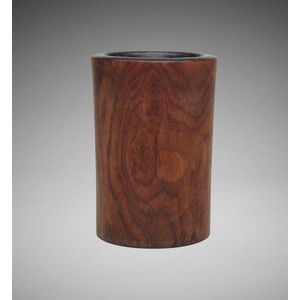Lacquer brush pot with script and floral decoration
You must be a subscriber, and be logged in to view price and dealer details.
Subscribe Now to view actual auction price for this item
When you subscribe, you have the option of setting the currency in which to display prices to $Au, $US, $NZ or Stg.
- Distressed - Usually applied to describe the condition of an item of furniture, and means that the object is extremely worn and is verging on being unsuitable for its intended use, without some restoration or repairs being undertaken.
Furniture can also be artificially distressed, by deliberate infliction of superficial damage to make it appear old. Artificial distressing can be done with the object of deceiving a purchaser, where the object is being passed off as "of the period", or can be done for aesthetic reasons so that a new object is made to appear as though it has been in use. - Arabesque - The arabesque pattern is an ornamental design that features flowing, curving lines and elaborate geometric shapes. It is inspired by the art and architecture of the Islamic world and was developed at Fontainebleu France in the mid 16th century. Its use was spread through published engravings, and it is characterized by its intricate and highly decorative nature. The arabesque pattern is created using a repetitive motif that is repeated and interwoven to create a cohesive design. It was used as a form of decoration in art, architecture, textiles, pottery, furniture and ceramics and it is often used to add a sense of grandeur and sophistication to a design. The arabesque pattern is admired for its beauty and complexity, and it continues to be used in a wide range of decorative contexts today.
- Lacquered Lacquerware - Lacquer is a clear or coloured resin that is obtained from the sap of several species of trees in the genus Rhus, particularly the Rhus verniciflua tree, which is native to China and Japan. The resin is harvested by making incisions in the tree bark and collecting the sap that oozes out.
The sap is then processed and refined through a series of steps, which may include filtration, heating, and chemical treatments. The resulting lacquer is a highly durable and glossy material that is used as a finish for furniture, musical instruments, and other objects.
Lacquer has been used for thousands of years in Asia, where it is valued for its beauty and durability. It is applied in multiple thin layers, with each layer being allowed to dry and harden before the next one is added. The process can take several weeks or even months to complete, but the resulting finish is incredibly hard, glossy, and resistant to scratches and wear.
The lacquer derived from the resin of the Rhus tree has been used for decoration of furniture in several countries in Asia, particularly China, Japan, Korea, and Vietnam. These countries have rich traditions of using lacquer for furniture decoration and have developed unique techniques and styles of lacquer work.
In China, lacquer has been used for furniture decoration for over 2,000 years, and it became a major art form during the Ming (1368-1644) and Qing (1644-1912) dynasties. Chinese lacquerware is known for its intricate carving, painting, and inlay work, as well as its use of bold colours and designs. Lacquer was used to decorate furniture such as cabinets, screens, and chairs.
In Japan, lacquer has been used for furniture decoration for over 1,000 years. Japanese lacquerware is characterized by its simplicity and elegance, and it often incorporates natural materials such as wood, bamboo, and shells. Lacquer was used to decorate furniture such as chests, cabinets, and trays.
In Korea, lacquer has been used for furniture decoration for over a thousand years. Korean lacquerware is known for its restrained and understated beauty, and it often features delicate patterns and designs that are achieved through careful layering and carving. Lacquer was used to decorate furniture such as cabinets, chests, and screens.
In Vietnam, lacquer has been used for furniture decoration for over 2,000 years. Vietnamese lacquerware is known for its vibrant colours and intricate designs, and it often features scenes from daily life, nature, and mythology
This item has been included into following indexes:
Visually similar items

A Burmese lacquer box 1925-50, with two interior trays, height 20 cm

A Chinese huanghuali brush pot, bitong, Late Ming to Early Qing dynasty 10.8 cm high, 7.5 cm diam. Provenance: NSW Private Collection

Small Japanese cloisonne brushpot, decorated with panels of birds on flowering branches. Height 8 cm. Provenance: Dr. John A. and Louise Gray 'Mark and Period' Collection.

A Chinese incised 'cabbage' bamboo brush pot, Attributed to Zhi Yan incised two verses to the back, 16 cm high
